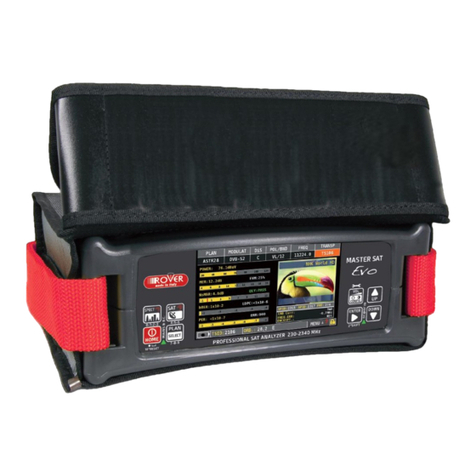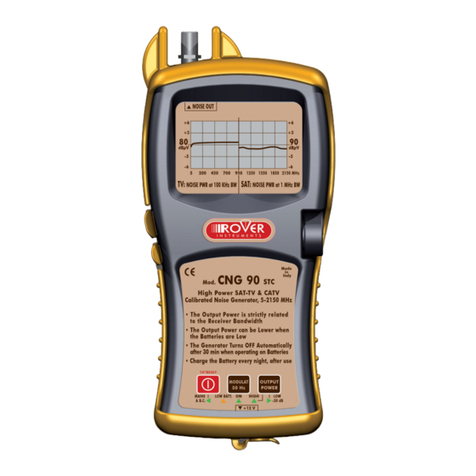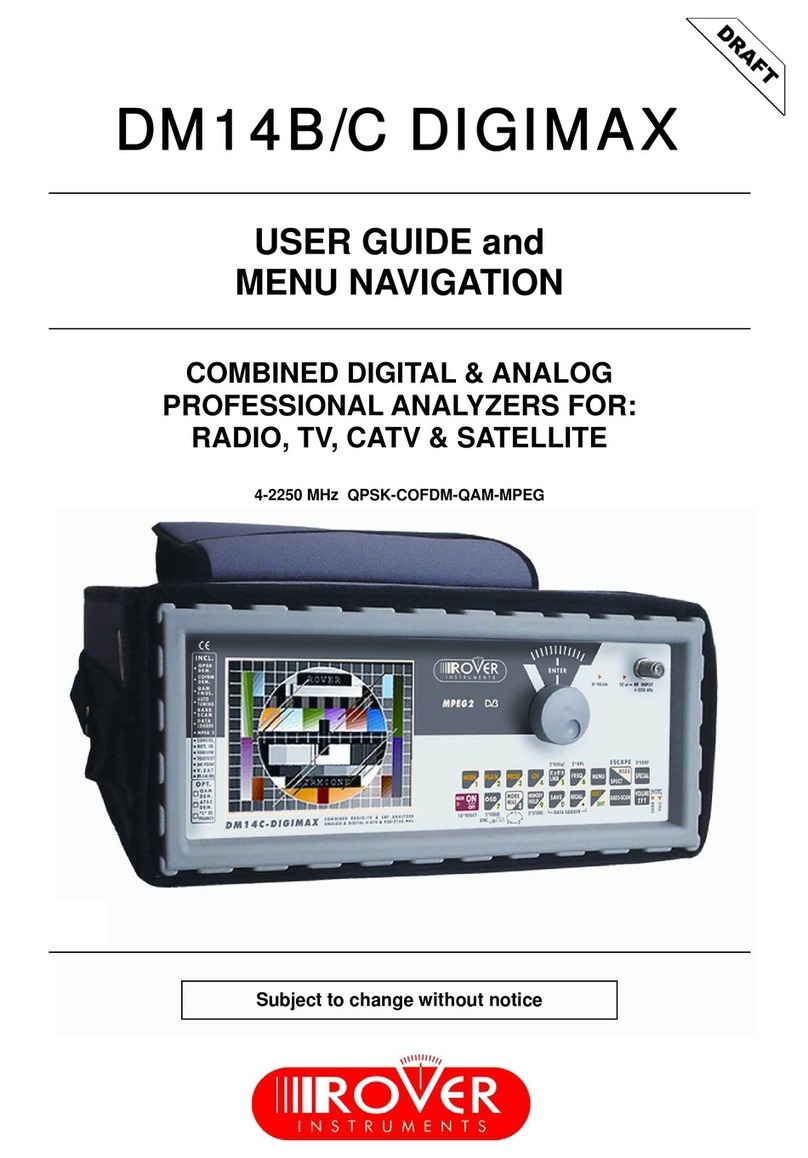MASTER STC
USER MANUAL
4
DIRECT FREQUENCY INPUT.............................................................................................................21
WHO IS THERE?AUTODISCOVERY ®...............................................................................................22
FM /FM RADIO SIGNALS TUNING [87,5 – 108 MHz]............................................................. 23
10.3 EXPLORE USER DEFINED CHANNEL................................................................................... 24
11 PERFORMING MEASURES: MEAS.................................................................................................. 25
11.1 THE SELECTED CHANNEL CARRIERS ON AN ANALOGUE TV SIGNAL........................... 25
VIDEO SIGNAL PEAK LEVEL MEASUREMENT .................................................................... 25
VIDEO Vs. AUDIO PEAK LEVEL RATIO AND SIGNAL TO NOISE RATIO............................ 26
SPECTRUM ANALYSIS OF THE TUNED CHANNEL............................................................. 26
11.2 THE SELECTED CHANNEL CARRIERS ON A DTT (COFDM) SIGNAL................................ 27
THE CHANNEL IS SUCCESSFULLY LOCKED (THE LOCK ON THE LCD BOTTOM-RIGHT
CORNER IS CLOSED).......................................................................................................... 27
NOISE MARGIN, QUALITY TEST, MER AND ERROR COUNT MEASUREMENTS ..........................27
BER MEASUREMENTS BEFORE AND AFTER ERROR CORRECTION VITERBI............................27
CONSTELLATION CHART AND OFDM PARAMETER.......................................................................28
IMPULSE RESPONSE OF THE SELECTED CHANNEL.....................................................................29
BOUQUET DATA ID.............................................................................................................................29
CHANNEL POWER MEASUREMENT.................................................................................................30
DISPLAYING THE SERVICE LIST OF THE CURRENT BOUQUET ...................................................31
BUZZER FUNCTION (ASSISTED ANTENNA ALIGNMENT)...............................................................31
SPECTRUM ANALYZER MODE..........................................................................................................32
THE CHANNEL IS NOT SUCCESSFULLY LOCKED (THE LOCK ON THE LCD BOTTOM-
RIGHT CORNER IS OPEN).................................................................................................. 32
11.3 THE SELECTED CHANNEL CARRIES ON A QAM (CATV) SIGNAL..................................... 33
THE CHANNEL IS SUCCESSFULLY LOCKED (THE LOCK ON THE LCD BOTTOM-RIGHT
CORNER IS CLOSED).......................................................................................................... 33
NOISE MARGIN, QUALITY TEST, MER AND ERROR COUNT MEASUREMENTS ..........................33
BER MEASUREMENTS BEFORE AND AFTER VITERBI ERROR CORRECTION............................33
CONSTELLATION CHART AND QAM PARAMETER .........................................................................34
BOUQUET DATA ID.............................................................................................................................35
CHANNEL POWER MEASUREMENT.................................................................................................35
DISPLAYING THE SERVICE LIST OF THE CURRENT BOUQUET ...................................................37
SPECTRUM ANALYZER MODE..........................................................................................................37
THE CHANNEL IS NOT SUCCESSFULLY LOCKED (THE LOCK ON THE LCD BOTTOM-
RIGHT CORNER IS OPEN).................................................................................................. 37
12 SPECTRUM ANALYZER MODE........................................................................................................ 38
12.1 SURFING THE CHANNELS..................................................................................................... 38
12.2 MOVING THE MARKER (FREQUENCY VALUE).................................................................... 38
12.3 EDITING THE SIGNAL LEVEL END OF SCALE..................................................................... 39
12.4 EDITING THE SPAN VALUE ................................................................................................... 39
12.5 ACTIVATE THE MAX HOLD FUNCTION................................................................................. 39
12.6 FULL BAND MAPPING............................................................................................................. 39
FULL BAND MAPPING DISPLAY CONFIGURATION............................................................. 39
SIGNAL LEVEL / CHANNEL POWER DETECTED INTO EACH CHANNEL (BARSCAN) ..................39
AUDIO AND VIDEO PEAK LEVEL DETECTED INTO EACH CHANNEL............................................39
SIGNAL LEVEL COMPARISON (TILT) BETWEEN TWO USERS-DEFINED CHANNEL....................39
ACTIVATE THE FULL BAND MAPPING.................................................................................. 40
FULL BAND SIGNAL LEVEL ANALYSIS IN EACH CHANNEL (LEVEL).............................................40
FULL BAND AUDIO AND VIDEO PEAK LEVEL ANALYSYS INTO EACH CHANNEL (AUD/VID)......40
FULL BAND SIGNAL LEVEL COMPARISON BETWEEN TWO USER-DEFINED CHANNELS (TILT)41
QAM CATV SIGNAL ANALYZER................................................................ 42
13 TUNING QAM CATV SIGNALS .........................................................................................................42






























